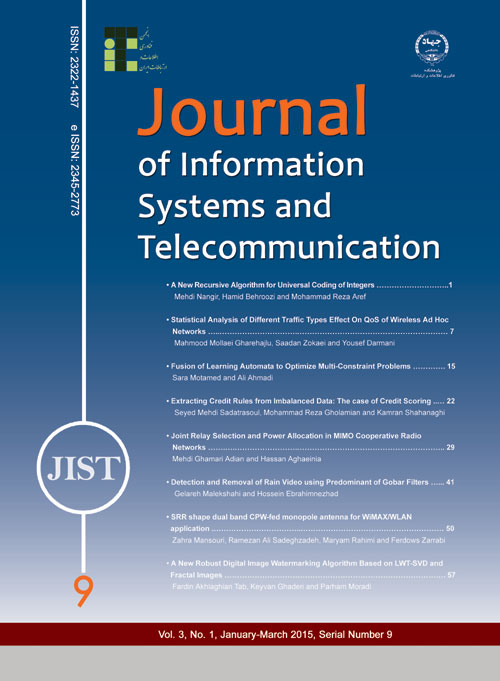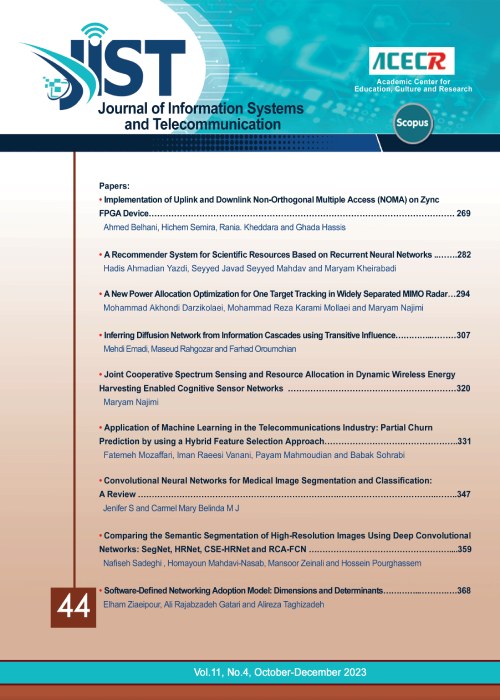فهرست مطالب

Journal of Information Systems and Telecommunication
Volume:3 Issue: 1, Jan-Mar 2015
- تاریخ انتشار: 1394/01/26
- تعداد عناوین: 8
-
-
Page 1In this paper, we aim to encode the set of all positive integers so that the codewords not only be uniquely decodable but also be an instantaneous set of binary sequences. Elias introduces three recursive algorithms for universal coding of positive integers where each codeword contains binary representation of the integer plus an attachment portion that gives some information about the first part [1]. On the other hand, Fibonacci coding which is based on Fibonacci numbers is also introduced by Apostolico and Fraenkel for coding of integers [2]. In this paper, we propose a new lossless recursive algorithm for universal coding of positive integers based on both recursive algorithms and Fibonacci coding scheme without using any knowledge about the source statistics [3].The coding schemes which don’t use the source statistics is called universal coding, in these universal coding schemes we should use a universal decoding scheme in the receiver side of communication system. All of these encoding and decoding schemes assign binary streams to positive integers and conversely, without any need of use to probability masses over positive integers. We show that if we use Fibonacci coding in the first part of each codeword we can achieve shorter expected codeword length than Elias Omega code. In addition, our proposed algorithm has low complexity of encoding and decoding procedures.Keywords: Universal Source Coding (data compression), Fibonacci Coding, Elias Coding Schemes, Integer Representation, Omega Coding, Redundancy
-
Page 7IEEE 802.11 based wireless ad hoc networks are highly appealing owing to their needless of infrastructures, ease and quick deployment and high availability. Vast variety of applications such as voice and video transmission over these types of networks need different network performances. In order to support quality of service for these applications, characterizing both packets arrival and available resources are essential. To address these issues we use Effective Bandwidth/Effective Capacity theory which expresses packet arrival and service model statistically. Effective Bandwidth asymptotically represents arrival traffic specifications using a single function. Also, Effective Capacity statistically describes service model of each node. Based on this theory, at first we modeled each node’s service as an ON/OFF process. Then a new closed form of Effective Capacity is proposed which is a simple function and is dependent on a few parameters of the network. Afterward the performance of different traffic patterns such as constant bit rate, Poisson and Markov Modulated Poisson process are statistically evaluated in the case of both single and aggregate traffic modes. Using the proposed model we will show that traffic pattern affects QoS parameters even if all models have the same average packet arrival rate. We prove the accuracy of our model by a series of simulations which are run using NS2 simulator.Keywords: Effective Bandwidth, Effective Capacity, Performance, CBR, Poisson, Markov Modulated Poisson Process
-
Page 16This paper aims to introduce an effective classification method of learning for partitioning the data in statistical spaces. The work is based on using multi-constraint partitioning on the stochastic learning automata. Stochastic learning automata with fixed or variable structures are a reinforcement learning method. Having no information about optimized operation, such models try to find an answer to a problem. Converging speed in such algorithms in solving different problems and their route to the answer is so that they produce a proper condition if the answer is obtained. However, despite all tricks to prevent the algorithm involvement with local optimal, the algorithms do not perform well for problems with a lot of spread local optimal points and give no good answer. In this paper, the fusion of stochastic learning automata algorithms has been used to solve given problems and provide a centralized control mechanism. Looking at the results, is found that the recommended algorithm for partitioning constraints and finding optimization problems are suitable in terms of time and speed, and given a large number of samples, yield a learning rate of 97.92%. In addition, the test results clearly indicate increased accuracy and significant efficiency of recommended systems compared with single model systems based on different methods of learning automata.Keywords: Stochastic Automata with Fixed, Variable Structures, Discrete Generalized Pursuit Automata, Fusion Method, Parallel Processing
-
Page 22Credit scoring is an important topic, and banks collect different data from their loan applicant to make an appropriate and correct decision. Rule bases are of more attention in credit decision making because of their ability to explicitly distinguish between good and bad applicants. The credit scoring datasets are usually imbalanced. This is mainly because the number of good applicants in a portfolio of loan is usually much higher than the number of loans that default. This paper use previous applied rule bases in credit scoring, including RIPPER, OneR, Decision table, PART and C4.5 to study the reliability and results of sampling on its own dataset. A real database of one of an Iranian export development bank is used and, imbalanced data issues are investigated by randomly Oversampling the minority class of defaulters, and three times under sampling of majority of non-defaulters class. The performance criterion chosen to measure the reliability of rule extractors is the area under the receiver operating characteristic curve (AUC), accuracy and number of rules. Friedman’s statistic is used to test for significance differences between techniques and datasets. The results from study show that PART is better and good and bad samples of data affect its results less.Keywords: Credit Scoring, Banking Industry, Rule Extraction, Imbalanced Data, Sampling
-
Page 29In this work, the issue of joint relay selection and power allocation in Underlay MIMO Cooperative Cognitive Radio Networks (U-MIMO-CCRN) is addressed. The system consists of a number of secondary users (SUs) in the secondary network and a primary user (PU) in the primary network. We consider the communications in the link between two selected SUs, referred to as the desired link which is enhanced using the cooperation of one of the existing SUs. The core aim of this work is to maximize the achievable data rate in the desired link, using the cooperation of one of the SUs which is chosen opportunistically out of existing SUs. Meanwhile, the interference due to the secondary transmission on the PU should not exceed the tolerable amount. The approach to determine the optimal power allocation, i.e. the optimal transmits covariance and amplification matrices of the SUs, and also the optimal cooperating SU is proposed. Since the proposed optimal approach is a highly complex method, a low complexity approach is further proposed and its performance is evaluated using simulations. The simulation results reveal that the performance loss due to the low complexity approach is only about 14%, while the complexity of the algorithm is greatly reduced.Keywords: Cognitive Radio Networks, Cooperative Communications, MIMO Systems, Low Complexity Approach
-
Page 41In this paper, we examine the visual effects of rain on the imaging system and present a new method for detection and removal of rain in a video sequences. In the proposed algorithm, to separate the moving foreground from the background in image sequences that are the frames of video with scenes recorded from the raindrops moving, a background subtraction technique is used. Then, rain streaks are detected using predominant direction of Gabor filters which contains maximum energy. To achieve this goal, the rainy image is partitioned to multiple sub images. Then, all directions of Gabor filter banks are applied to each sub image and the direction which maximizes the energy of the filtered sub image is selected as the predominant direction of that region. At the end, the rainy pixels diagnosed in per frame are replaced with non-rainy pixels background of other frames. As a result, we reconstruct a new video in which the rain streaks have been removed. According to the certain limitations and existence of textures variation during time, the proposed method is not sensitive to these changes and operates properly. Simulation results show that the proposed method can detect and locate the rain place as well.Keywords: Inpainting, Background Subtraction, Removal of Rain, Gabor Filters, Rain Detection
-
Page 50CPW structure is became common structure for UWB and multi band antenna design and SRR structure is well-known kind of metamaterial that has been used in antenna and filter design for multi band application. In this paper, a SRR dual band monopole antenna with CPW-fed for WLAN and WiMAX is presented. The prototype antenna is designed for wireless communication such as WLAN and WIMAX respectively at 2.4 GHz and 5 GHz. The HFSS and CST microwave studio are used to simulate the prototype antenna for two different FEM and time domain method and they have also been compared with the experimental results. The total size of the antenna is 60mm×55mm×1.6mm and it is fabricated on FR-4 low cost substrate. The antenna is connected to a 50 Ω CPW feed line. Its bandwidth is around 3% for 2.45 GHz (2.4-2.5 GHz) and 33% for 5.15GHz (4.3-6 GHz).Its limited bandwidth in 2.4 GHz frequency is benefit for power saving at indoor application. The antenna has 2-7 dBi gain in the mentioned bands with an Omni-directional pattern. The antenna experimental result shows good similarity to simulation kind for return loss and pattern. Here, the effect of parasitic SRR on current distribution has been studied in presence and absence of parasitic element. The simulation of polarization is confirmed that the antenna has linear polarization. Here comparison between antenna return losses in absence of each parasitic element is presented.Keywords: CPW, fed, SRR, Dual Band Antenna, WLAN
-
Page 57This paper presents a robust copyright protection scheme based on Lifting Wavelet Transform (LWT) and Singular Value Decomposition (SVD). We have used fractal decoding to make a very compact representation of watermark image. The fractal code is presented by a binary image. In the embedding phase of watermarking scheme, at first, we perform decomposing of the host image with 2D-LWT transform, then SVD is applied to sub bands of the transformed image, and then the watermark, “binary image,” is embedded by modifying the singular values. In the watermark extraction phase, after the reverse steps are applied, the embedded binary image and consequently the fractal code are extracted from the watermarked image. The original watermark image is rendered by running the code. To verify the validity of the proposed watermarking scheme, several experiments are carried out and the results are compared with the results of the other algorithms. In order to evaluate the quality of image, we use parameter peak value signal to-noise ratio (PSNR). To measure the robustness of the proposed algorithm, the NC coefficient is evaluated. The experimental results indicate that, in addition to high transparency, the proposed scheme is strong enough to resist various signal processing operations, such as average filter, median filter, Jpeg compression, contrast adjustment, cropping, histogram equalization, rotation, etc.Keywords: Image Watermarking, Lifting Wavelet Transforms, Singular Value Decomposition, Fractal Image


